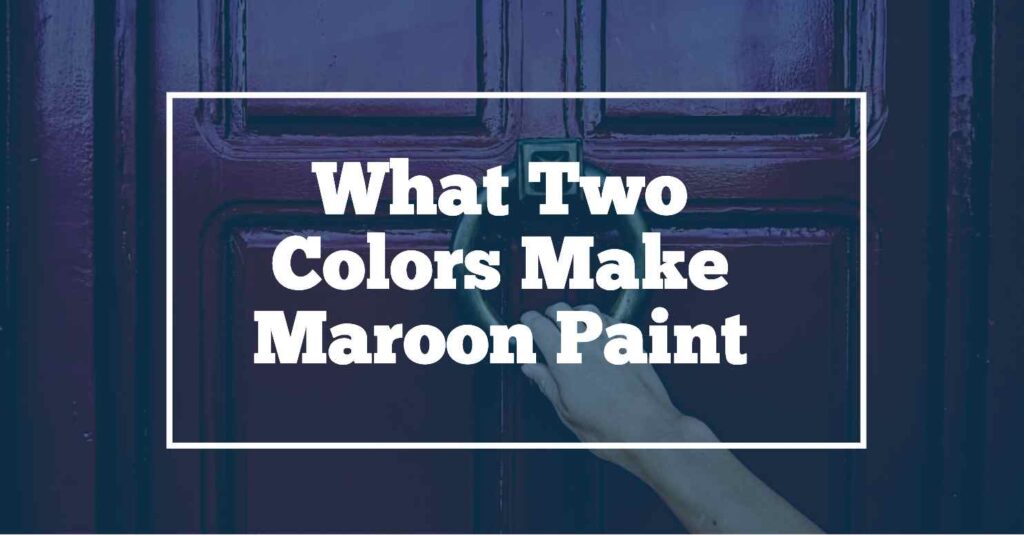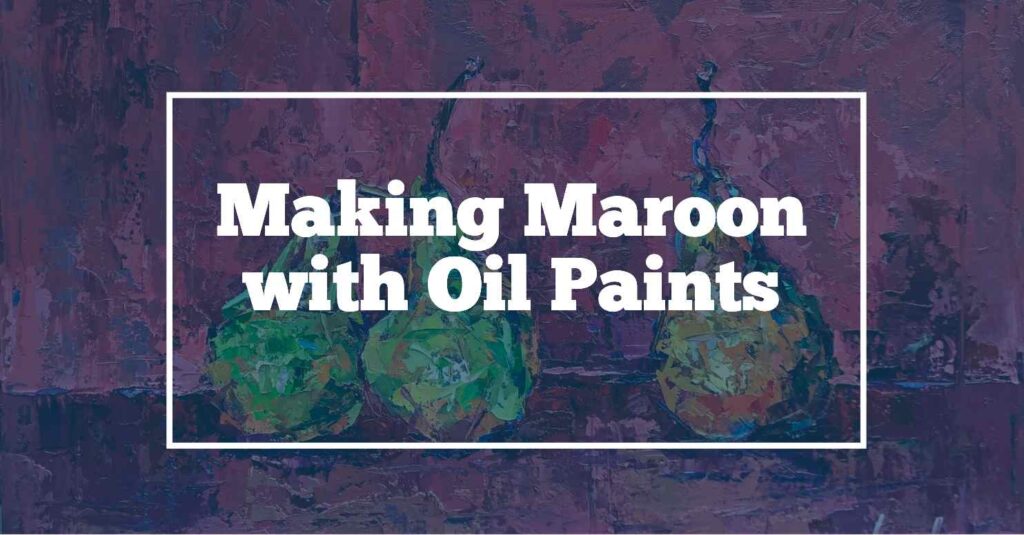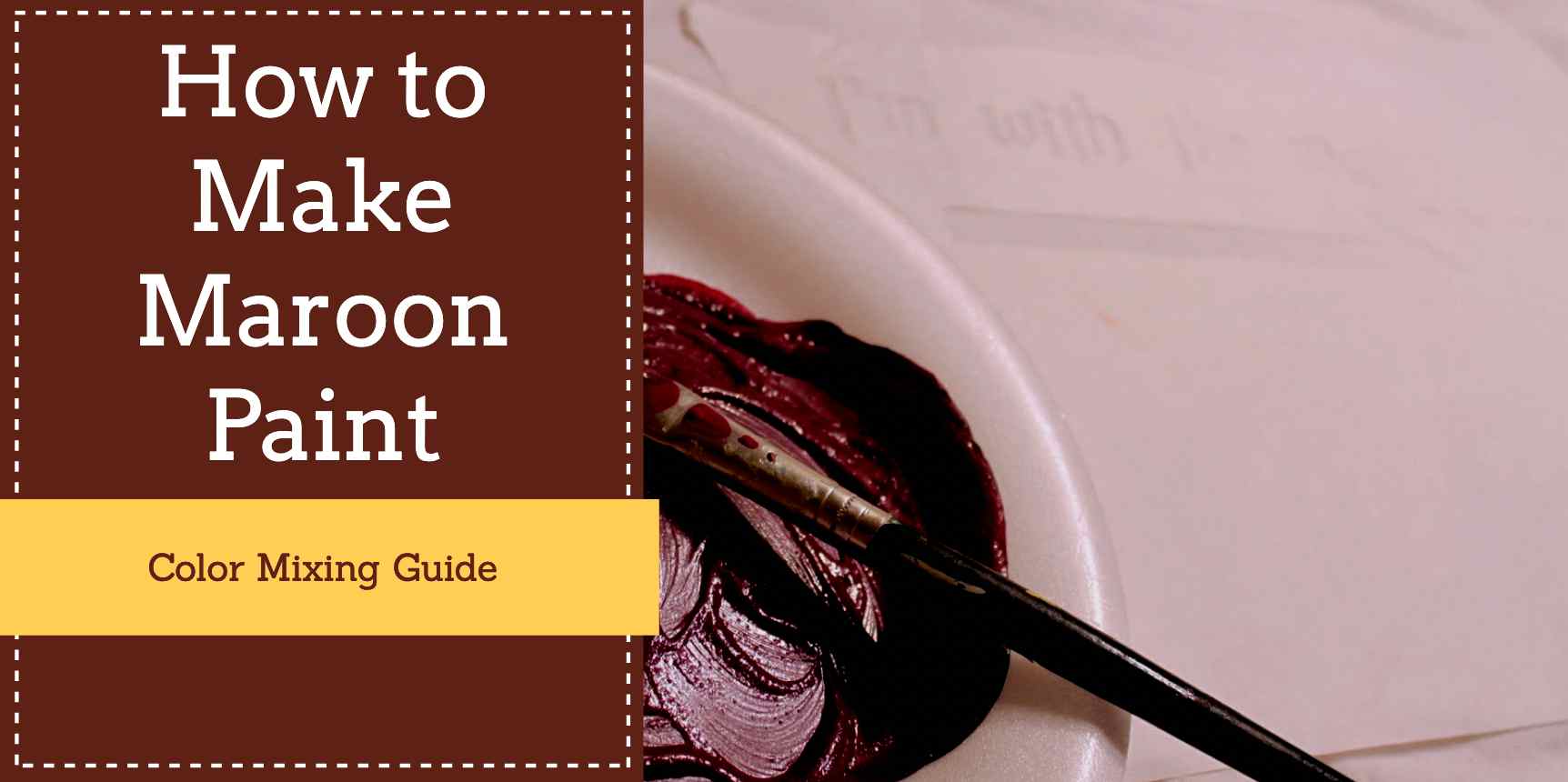Sometimes when you get in need of buying Maroon color, it must come to your mind “I wish I knew how to make that deep, rich maroon color?” Maroon is a shade that feels cozy, elegant, and timeless. While it might seem difficult to get that perfect maroon tone, it’s easier than you might think. In essence, it’s about blending the right amounts of primary colors. Sure, it’s not as simple as mixing red and blue; there’s a bit more difference to it. But with this guide, anyone can achieve that perfect maroon shade. Whether you’re painting your bedroom, crafting a piece of art, or just experimenting with colors, knowing how to make maroon can be a great skill to learn. , Here we’ll walk you through a straightforward process to whip up your very own batch of maroon paint. Let’s get started!
Also Read: How To Make Hot Pink Paint
What Two Colors Make Maroon Paint

Maroon is one of those colors that draw attention. It’s a warm, deep shade that sits somewhere between red and purple on the color spectrum. So, how do you make it? Start with a good amount of red, which is the main ingredient in our maroon recipe. Red brings that familiar warmth and depth. Next, sprinkle in some blue. As you add the blue to the red, you’ll notice the color start to change, deepening into that maroon we’re aiming for. But don’t be fast! Add the blue slowly, watching the transformation. Sometimes, to get the exact depth or richness, you might also want to mix in a tiny bit of brown or black. It’s all about tweaking until you get your perfect desired color. Whether you’re an artist, a DIY enthusiast, or someone trying out a new hobby, making maroon is something like cooking, you need to mix & adjust until you get your perfect desired shade.
Making Maroon using Acrylics: A Step-by-Step Guide
When it comes to painting, maroon is a shade that oozes elegance. But rather than reaching for a pre-mixed tube, Here, we’ll be making our own Maroon using acrylic paints. With each step, you’ll find this process simple, engaging, and truly rewarding.
1. Get Ready with Your Supplies: To begin, ensure you have your primary acrylic paints on hand, especially a good-quality red and blue. A palette for mixing and a palette knife or brush for blending will also be essential.
2. Start With Your Red Foundation: Start by squeezing a generous amount of red paint onto your palette. This vibrant hue is the backbone of our maroon shade.
3. Introduce the Blue: Now, here’s where you need to be a bit careful. Slowly add a small amount of blue to the red. You might be tempted to add a lot, but remember, we can always add more blue later if needed.
4. Blend Gently: Using your palette knife or brush, blend the colors together. Watch as the bright red starts to darken and transform. The result should be a shade that’s getting closer to the rich maroon you envision.
5. Tweak and Adjust: Analyse the shade. Is it the maroon you were picturing? If it’s too red, add a tiny bit more blue, but if it’s veering toward purple, bring in more red.
6. Deepen if Desired: For those aiming for a deeper or more muted maroon, a little brown or a speck of black can be added. This step is like adding seasoning to taste in cooking, so be sparing and mix well after each addition.
7. Test Before Using: Before committing it to your artwork, test your freshly mixed maroon on a scrap piece of paper or canvas. This way, you’ll see how it looks when applied and can make any last-minute adjustments.
8. Celebrate Your Creation: And voilà! You now have a beautiful shade of maroon, crafted with your own hands. Whether you’re painting a landscape, a portrait, or simply experimenting, this shade is bound to enhance your piece.
Remember, every artist has their own way, and the beauty of mixing your own colors is that you can tweak them to your heart’s content. So don’t worry about playing with colors and find the maroon that’s just right for you.
Making Maroon with Oil Paints: A Detailed Step-by-Step Guide

Mixing colors in oil paints feels a bit like alchemy. The textures, the richness, and the way colors come alive with oils are genuinely captivating. Let’s go straight into creating the ever-elegant maroon shade using oil paints.
1. Preparation First: Before starting, ensure you’ve got a clean palette and palette knife. With oils, cleanliness is vital to prevent unintentional color mixing. Also, have your primary oil paints, especially red and blue, within arm’s reach.
2. The Red Base: Begin by placing a good amount of red paint onto your palette. Red is the heart of maroon, and it’s what gives the color its warmth and depth.
3. Add a Touch of Blue: This step requires patience. Gently introduce a small amount of blue into the red. Oil paints often have a deep color concentration, so adding too much blue too quickly can easily shift your mix toward purple.
4. Blend with Care: Using your palette knife, blend the two colors thoroughly. The aim is to see the bright, dominant red gradually adopt a deeper, more sophisticated tone.
5. Refine the Shade: Check the resulting color. If it still feels too red or bright for maroon, integrate a little more blue. Conversely, if it’s starting to look too purple or dark, redress the balance with more red.
6. For a Richer Maroon: Sometimes, maroon can benefit from extra depth. To achieve this, add a tiny hint of brown or even a drop of black. This should be done cautiously, ensuring the color doesn’t get too dark or muddy.
7. Sample the Shade: Before you apply the mixed maroon to your primary artwork, test it out. Brush a small swatch onto a spare canvas or paper to see how it dries. Oil paints, most of the time dry slightly differently than they appear wet.
8. Admire and Use: With your custom-made maroon now ready, it’s time to bring your artistic visions to life. The satisfaction of using a shade you’ve mixed yourself adds a personal touch to every artwork.
The art of mixing oil paints is both a science and a feeling. Every artist brings their unique touch to it, so enjoy the process, and don’t hesitate to modify until you achieve your perfect maroon. Enjoy your painting journey!
Also Read: How To Make Magenta Paint
Blending Maroon with Watercolors: A Step-by-Step Exploration
As we’ve told you about making Maroon with Acrylics & Oil paints. Now, let’s explore the art of creating a lovely maroon shade using watercolors.
1. Get Ready With Prerequisites: Assemble all your tools — a clean palette, brushes, a jar of clean water, and of course, your primary watercolor pans or tubes, focusing on red and blue.
2. Start With the Red: Wet your brush and pick up a good amount of red paint. Apply this to your palette, ensuring the color is vibrant but not too watery. Remember, watercolor mixing is about balancing pigment and water.
3. Introduce Blue: With a clean, damp brush, pick up a small amount of blue and gently mix it into the red on your palette. The watery nature of watercolors means colors can blend rapidly, so it’s crucial to add blue little by little.
4. Stir and Observe: As you mix, you’ll notice the red deepening, moving towards the desired maroon. The transparency of watercolors means that the mixing might look lighter when wet but will darken slightly as it dries.
5. Adjust Accordingly: If your mixture leans too much towards purple, reintroduce a bit more red. The goal is to strike a balance where the hue feels rich and warm, synonymous with maroon.
6. Add Depth if Needed: For a deeper maroon, consider a touch of brown or even a faint hint of black. But proceed with caution; watercolors can change significantly with just a little addition.
7. Test Your Mix: Before committing to your main artwork, try a little on a piece of watercolor paper. This will give you an idea of how it’ll look when dried, allowing for any last-minute tweaks.
8. Paint with Pride: With your custom maroon ready, start your artwork. There’s something uniquely satisfying about painting with a color you’ve blended yourself.
Watercolors, by nature, are fluid and unpredictable, this is a great thing about them. Embrace the process, enjoy the serendipities, and revel in the joy of creating your very own shade of maroon.
FAQs
1. Why does maroon vary across mediums?
Each painting medium, be it acrylic, oil, or watercolor, has its own pigment density and transparency levels. This means the resultant maroon shade can differ due to the medium’s inherent properties, even if you follow similar mixing guidelines.
2. Can I use the same red and blue for all mediums?
While the basic concept remains similar, specific brands or types within each medium might have variations in hue intensity. It’s always a good idea to test and adjust as needed for each medium separately.
3. Why does my maroon look too purple in acrylics?
Acrylic paints can be quite vibrant. If your mix going toward purple, it suggests an excess of blue. Simply add more red to bring it back to a maroon shade.
4. How do I achieve a deeper maroon in oil paints?
Oil paints are rich and dense. For a deeper maroon, introduce a touch of brown or even a tiny amount of black. Mix well to ensure even distribution of the new pigment.
5. Why does my watercolor maroon seem too light?
Watercolors are translucent by nature. If your maroon feels too light, it’s likely due to excess water. Pick up more pigment or allow your mix to dry slightly before applying for a richer shade.
6. Can I speed up the drying process for oil-based maroon?
Oil paints inherently take longer to dry. While you can’t rush the natural drying time too much, using a drying medium or placing the artwork in a warm, dry environment can help speed things up a bit.
7. Do I need to use a medium when mixing acrylics?
While acrylics can be mixed directly, using a medium can improve flow and bendability, especially when striving for smoother gradients or transitions in shades like maroon.
8. Why does my maroon look different when dried?
Most paints, especially watercolors, undergo a color shift as they dry. It’s always recommended to test a small patch, let it dry, and then adjust your mix if necessary.
9. Can I store my mixed maroon for future use?
Absolutely! With acrylics and oils, transfer your mixed color to a sealed container or airtight palette. For watercolors, let the mix dry on the palette, and you can reactivate it with water when needed.
10. How can I use maroon in my artwork?
Maroon is versatile. Whether as a background shade, an accent color, or to provide depth in shadows, its richness can elevate any artwork. Experiment, play, and see how maroon can bring a touch of sophistication to your pieces.
Conclusion:
So, we’ve taken a close look at how to mix and make maroon in acrylics, oil paints, and watercolors. Each type of paint has its own way of blending, and there’s no one-size-fits-all method. The main thing to remember is to start with red and add blue slowly, tweaking as you go along. Depending on the paint type, you might also add a bit of brown or black to get that perfect shade. But here’s a tip, don’t worry about the experiment! The more you play with colors, the better you’ll get at it. And at the end of the day, there’s nothing like the satisfaction of creating your own unique shade of maroon. So grab those paints and give it a try!

